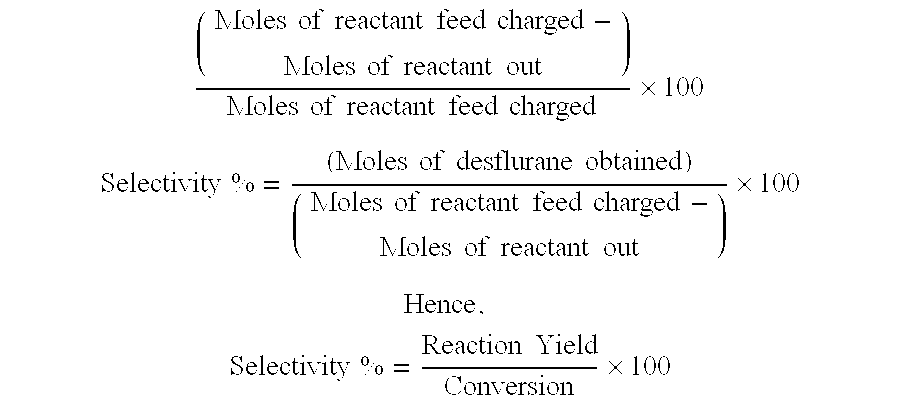Process for production of 1,2,2,2-tetrafluoroethyl difluoromethyl ether (desflurane)
a technology desflurane, which is applied in the field of process for the preparation of tetrafluoroethyl difluoromethyl ether, can solve the problems of difficult scaling up for commercial purposes, low yield of desflurane, and formation of significant amounts of other polyfluorinated ether isomers, and achieve high conversion efficiency
- Summary
- Abstract
- Description
- Claims
- Application Information
AI Technical Summary
Benefits of technology
Problems solved by technology
Method used
Image
Examples
example 1
[0048]The fluorination catalyst was prepared, charged, conditioned and heated to the reaction temperature (150° C.) as described above. The metal pentahalide employed in the process was antimony pentachloride in molar equivalents of 1.1 mmol / g. The supporting substrate employed was the activated carbon. The pressure of the system was 0-0.2 bar.
[0049]Isoflurane was fed continuously as a vapour at a rate of 22.3 g / hr and anhydrous HF vapour was fed at a rate of 4.6 g / hr in the reactor with a resulting molar feed ratio of isoflurane:HF of 1:1.9. The reaction temperature was maintained at 153° C. in the reactor. The reaction was allowed to stabilise for 2 hours. The reaction was then run for further 6 hours.
[0050]The total feed after the period of stabilisation was found to be isoflurane, 133.7 g (0.725 m) and anhydrous hydrogen fluoride, 27.3 g (1.37 m). The desflurane product was condensed and neutralised as described above. The final combined product was analyzed as desflurane 57.4%,...
example 2
[0051]The fluorination catalyst was prepared, charged, conditioned and heated to the reaction temperature (135° C.) as described above. The metal pentahalide used in this process was antimony pentafluoride in molar equivalents of 1.5 mmol / g. The supporting substrate employed was activated carbon. The pressure of the system was 0-0.2 bar.
[0052]Isoflurane was fed continuously as a vapour at a rate of 16 g / hr and anhydrous HF vapour was fed at a rate of 5.0 g / hr to the reactor with a resulting molar feed ratio of isoflurane:HF of 1:2.8. The reaction temperature was maintained at 135° C. in the reactor. The desflurane product was condensed and neutralized as described above and routinely sampled and analysed. The reaction was then continued to run for 110 hours. The analysis after 10 hours of stabilisation indicated 80% to 83% desflurane product recovered with most of the balance being isoflurane. The final bulk product after drying with sodium sulphate, was analyzed as desflurane 81.9%...
PUM
| Property | Measurement | Unit |
|---|---|---|
| temperature | aaaaa | aaaaa |
| molar ratio | aaaaa | aaaaa |
| temperature | aaaaa | aaaaa |
Abstract
Description
Claims
Application Information
 Login to View More
Login to View More - R&D
- Intellectual Property
- Life Sciences
- Materials
- Tech Scout
- Unparalleled Data Quality
- Higher Quality Content
- 60% Fewer Hallucinations
Browse by: Latest US Patents, China's latest patents, Technical Efficacy Thesaurus, Application Domain, Technology Topic, Popular Technical Reports.
© 2025 PatSnap. All rights reserved.Legal|Privacy policy|Modern Slavery Act Transparency Statement|Sitemap|About US| Contact US: help@patsnap.com


